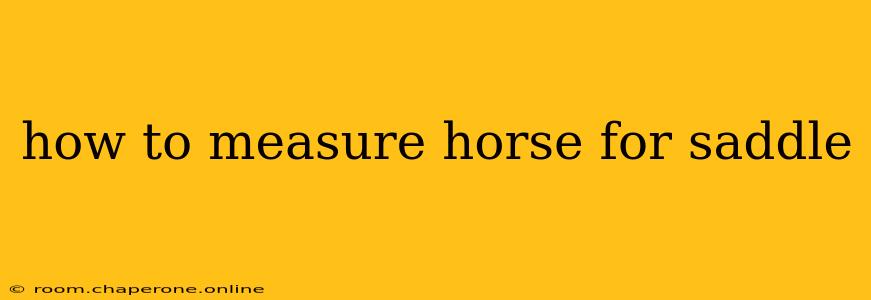Finding the right saddle for your horse is crucial for both their comfort and your riding experience. An ill-fitting saddle can lead to discomfort, sores, and even serious injuries. Accurate measurement is the first step in ensuring a proper fit. This guide will walk you through the essential measurements needed to determine the correct saddle size for your equine partner.
Essential Measurements for Saddle Fit
Before you start, gather a flexible tape measure and a helper. It's much easier to take accurate measurements with assistance. Remember to keep the tape measure snug but not overly tight.
1. Back Length
This is perhaps the most crucial measurement. It determines the saddle's overall length and its ability to sit correctly on your horse's back.
- Measurement Point: Measure from the point of the horse's withers (the highest point of their shoulders) to the point where their tail begins. This area should be relatively straight; avoid curving the tape measure around the horse's back.
- Importance: A saddle that's too short will pinch at the withers, while a saddle that's too long will slide back, causing discomfort and potential injury.
2. Wither Height
The wither height helps determine the saddle's tree size, which affects its overall fit and comfort.
- Measurement Point: Measure from the highest point of the withers to the ground.
- Importance: This measurement, in conjunction with the horse's back length, helps narrow down appropriate saddle sizes. It also helps ensure the saddle sits correctly on the horse's back, avoiding pressure points.
3. Gullet Width
The gullet is the space between the saddle's pommel (front) and cantle (back). A properly fitting gullet allows for adequate clearance of the horse's spine. This measurement often requires a specialized tool, but a visual inspection is useful as well.
- Measurement Point: While difficult to measure precisely without specialized tools, visually assess the width of your horse's spine at the wither area. A narrow horse needs a narrow gullet, while a broad horse will need a wider one.
- Importance: An incorrect gullet width can put pressure on the horse's spine, causing discomfort and potential damage.
4. Saddle Area Width
This measurement assesses the broadest part of the horse's back where the saddle sits.
- Measurement Point: Measure the widest part of your horse's back, roughly where the saddle panels sit.
- Importance: Helps to ensure the saddle panels distribute weight evenly across the horse's back.
5. Barrel Size (Circumference)
The barrel size gives an indication of the saddle's seat size and overall fit.
- Measurement Point: Measure the circumference of your horse's body just behind the withers.
- Importance: While not directly related to saddle tree size, it provides context when assessing overall saddle fit. A larger horse may require a larger saddle seat.
Beyond Measurements: Visual Inspection
Measurements are only part of the equation. A thorough visual inspection is crucial to confirm a proper fit. Look for:
- Clearance of the Spine: Ensure there's sufficient space between the saddle and the horse's spine.
- Even Weight Distribution: The saddle should sit evenly on the horse's back, without tilting or shifting.
- No Pressure Points: Check for any signs of pressure points, such as redness or hair loss.
Seeking Professional Advice
While these measurements are helpful, the best way to ensure a proper saddle fit is to consult a professional saddle fitter. They have the expertise and tools to accurately assess your horse's conformation and recommend the ideal saddle. A professional fitting is an investment in your horse's well-being and your riding enjoyment.
By carefully measuring your horse and seeking expert advice, you can ensure they have a comfortable and safe riding experience. Remember, a well-fitting saddle is essential for preventing injuries and maintaining your horse's health.

